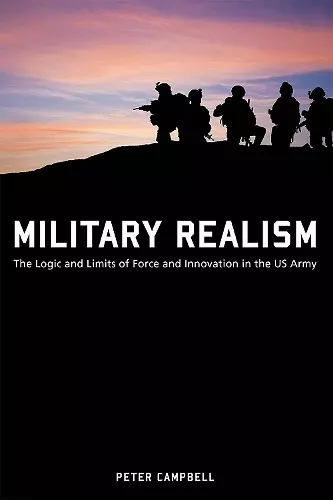Military Realism
The Logic and Limits of Force and Innovation in the U.S. Army
Format:Paperback
Publisher:University of Missouri Press
Published:30th Apr '24
Should be back in stock very soon

After the Vietnam War, the U.S. Army considered counterinsurgency (COIN) a mistake to be avoided. Many found it surprising, then, when setbacks in recent conflicts led the same army to adopt a COIN doctrine. Scholarly debates have primarily employed existing theories of military bureaucracy or culture to explain the army’s re-embrace of COIN, but Peter Campbell advances a unique argument centering on military realism to explain the complex evolution of army doctrinal thinking from 1960 to 2008.
In five case studies of U.S. Army doctrine, Campbell pits military realism against bureaucratic and cultural perspectives in three key areas—nuclear versus conventional warfare, preferences for offense versus defense, and COIN missions—and finds that the army has been more doctrinally flexible than those perspectives would predict. He demonstrates that decision makers, while vowing in the wake of Vietnam to avoid (COIN) missions, nonetheless found themselves adapting to the geopolitical realities of fighting “low intensity” conflicts. In essence, he demonstrates that pragmatism has won out over dogmatism. At a time when American policymakers remain similarly conflicted about future defense strategies, Campbell’s work will undoubtedly shape and guide the debate.
“An important contribution to the scholarship on military doctrine and its importance to international relations and security studies.”—Benjamin Jensen, American University, author of Forging the Sword: Doctrinal Change in the U.S. Army
"Peter Campbell provides an insightful analysis of the U.S. Army's internal dynamics for reform. He has a rare understanding of the motivation of the American military to overcome bureaucratic inertia to carry out its responsibilities to best provide for the common defense of the nation."—Conrad Crane, author of Cassandra in Oz: Counterinsurgency and Future War
"Campbell offers a convincing argument that 'military realism' best explains the evolution of the U.S. Army's doctrine from the Kennedy through the George W. Bush administrations. . . . Military Realism: The Logic and Limits of Force and Innovation in the US Army is essential reading for scholars, practitioners, and citizens seeking to understand the origins and substance of Army doctrine and the historic interplay of the civilian and military thinking driving the process of doctrinal innovation."—Marybeth Peterson Ulrich, General Maxwell D. Taylor Chair of the Profession of Arms, US Army War College
"Although Army doctrine aficionados will most appreciate the rigor and care with which Campbell analyzes the doctrinal evolution of the Army, this book will have widespread appeal to those who wish to understand why and how the Army got to where it is today. It provides rich historical context of key events and senior leaders’ decision-making processes."—Army Magazine “Anyone interested in civil-military relations or political science theories of doctrinal change should certainly read this book. Most importantly, top civilian officials with influence over the military should study this book to gain a better understanding of the mentality of senior military officers. . . . Campbell’s work is expertly researched, exhaustively defended, and an insightfully novel piece of scholarship.”—Army History
ISBN: 9780826223128
Dimensions: 229mm x 152mm x 41mm
Weight: 272g
390 pages